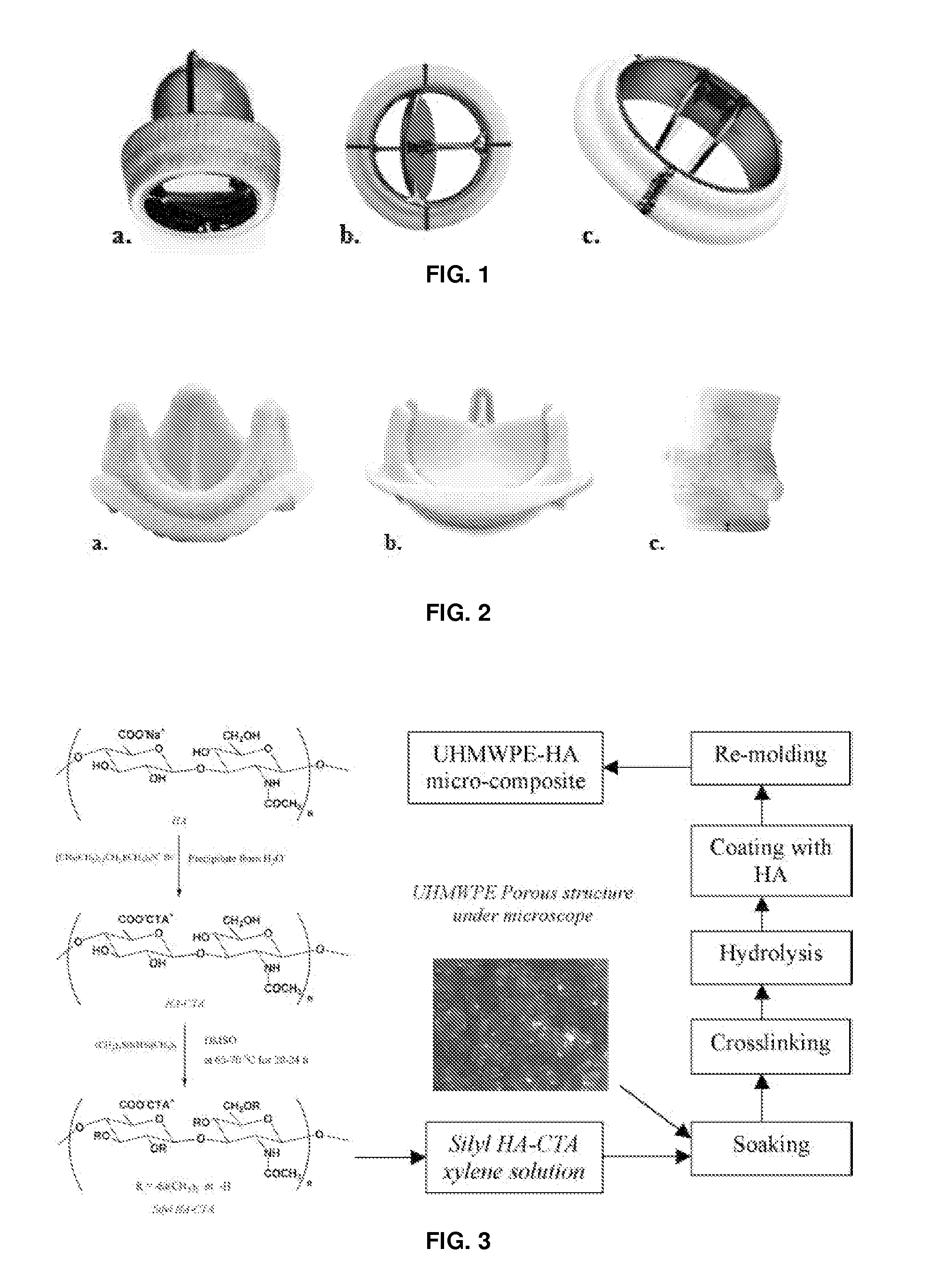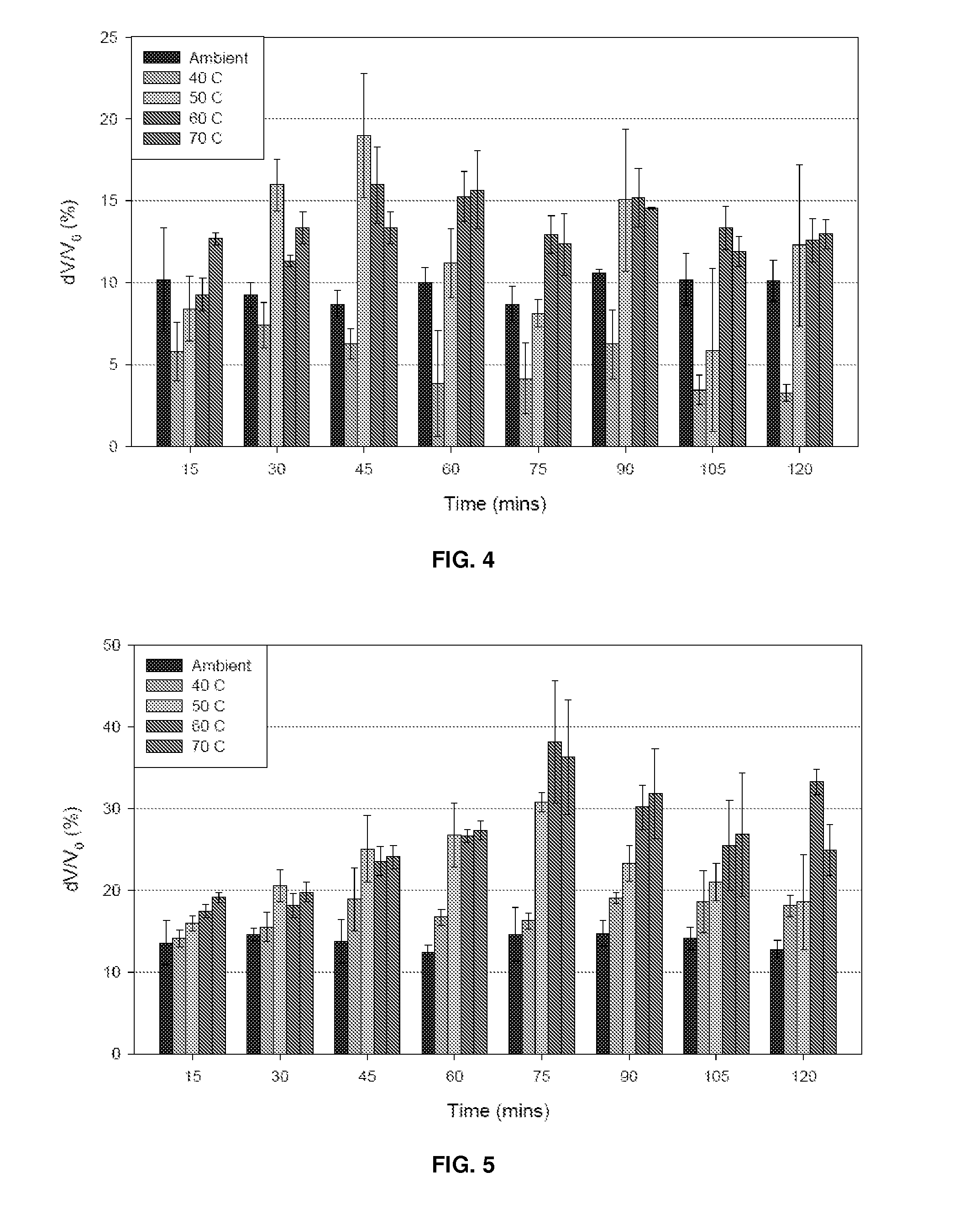Glycosaminoglycan and Synthetic Polymer Material for Blood-Contacting Applications
a synthetic polymer and glycosaminoglycan technology, applied in the field of biocompatible materials and medical equipment and methods, can solve the problems of short lifespan, lack of durability, and high cost of hv replacement, and achieve the effects of improving the surface chemistry of the polymer, commercial production of hyaluronan-containing materials, and affordable and practicality
- Summary
- Abstract
- Description
- Claims
- Application Information
AI Technical Summary
Benefits of technology
Problems solved by technology
Method used
Image
Examples
example 1
Swelling of the Host Polymer
[0154]To form hyaluronic acid (HA) in a linear low-density polyethylene (LLDPE) polyethylene terephthalate (PET), or expanded polytetrafluoroethylene (ePTFE) microcomposite, the degree of swelling and swelling kinetics in a solvent of interest were analyzed. A study was performed to understand the above parameters for the swelling of the LLDPE in a range of solvent temperatures in order to identify the swelling parameters to be used in the microcomposite synthesis.
[0155]LLDPE samples were blow-molded from known resins by Flex-Pack Engineering, Inc. (Uniontown, Ohio) with known melt indexes, densities, and crystallinities. Samples had a specified thickness of 0.002″ (0.0508 mm) without additional fillers or surface treatment. The first type of LLDPE used was film molded from Dowlex™ 2344 resin with a melt index of 0.7 g / 10 min, a density of 0.933 g / cm3 and a crystallinity of 42.26±1.35%. The second type of LLDPE used study was film molded from Dowlex™ 2056...
example 2
Synthesis of Silyl-HA-CTA
[0168]To produce cetyltrimethylammonium silylhyaluronate (silyl HA-CTA), dimethyl sulfoxide (DMSO) was added to cetyltrimethylammonium hyaluronate (HA-CTA) under dry N2 flow. The solution was stirred at 50° C. until the HA-CTA was completely dissolved. The HA-CTA and DMSO solution temperature was increased to 75° C., and hexamethyldisilazane (HMDS) was added under dry N2 flow. The reaction was carried out for at least about 36 hours. Once stirring ceased, the resultant biphasic solution was separated. The top layer was saved and vacuum dried at 50° C. until no change in weight was observed. The bottom layer was discarded. The dry powder, characterized to be silyl HA-CTA, was washed five times with xylenes. The washed silyl HA-CTA was dried again under vacuum at 50° C. vacuum until no change in weight was observed.
example 3
Synthesis Composites from LLDPE, PET, and ePTFE
[0169]All treated LLDPE BioPoly™ (LLDPE-T) samples were fabricated from blown LLDPE film. All treated PET BioPoly™ (PET-T) samples were fabricated from stretch knit PET, as described in Example 1. The synthesis parameters of LLDPE-T and PET-T samples are shown in Table 1.
TABLE 1Table of synthesis paramatersConc. ofDipConc.Conc. of silylCross-Hydro-withOfSampleHAlinkerlysisHA?HA?LLDPE-TSilyl HA-CTADesmodur ™AfterNon.a 0.5-50 mg / mL2%Treat-1.5-150 mg / mLment2.5-250 mg / mLLLDPE-T-Silyl HA-CTADesmodur ™BeforeYes1%D 0.5-50 mg / mLHA Dip1.5-150 mg / mL2%2.5-250 mg / mLPET-TSilyl HA-CTADesmodur ™AfterNon.a 0.5-50 mg / mL2%Treat-1.5-150 mg / mLment2.5-250 mg / mLPET-T-DSilyl HA-CTADesmodur ™BeforeYes1% 0.5-50 mg / mL2%HA Dip1.5-150 mg / mL2.5-250 mg / mL* n.a. = not applicable
[0170]The HA treatment processes for LLDPE-T and PET-T differed due to the swelling kinetics (FIG. 15). LLDPE film and PET fabric were soaked in xylenes for 12 hours and vacuum dried another 1...
PUM
| Property | Measurement | Unit |
|---|---|---|
| thickness | aaaaa | aaaaa |
| thickness | aaaaa | aaaaa |
| aqueous contact angle | aaaaa | aaaaa |
Abstract
Description
Claims
Application Information
 Login to View More
Login to View More - R&D
- Intellectual Property
- Life Sciences
- Materials
- Tech Scout
- Unparalleled Data Quality
- Higher Quality Content
- 60% Fewer Hallucinations
Browse by: Latest US Patents, China's latest patents, Technical Efficacy Thesaurus, Application Domain, Technology Topic, Popular Technical Reports.
© 2025 PatSnap. All rights reserved.Legal|Privacy policy|Modern Slavery Act Transparency Statement|Sitemap|About US| Contact US: help@patsnap.com



